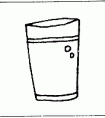Inwinter,there _____________ inBeijing.[ ]A.arealotofsnowsB.islotsofsnowC.aremanysnows-六年级英语
题文
| In winter, there _____________ in Beijing. |
|
[ ] |
| A. are a lot of snows B. is lots of snow C. are many snows |
答案
| B |
据专家权威分析,试题“Inwinter,there _____________ inBeijing.[ ]A.arealotofsnows..”主要考查你对 不可数名词,there be 句型 等考点的理解。关于这些考点的“档案”如下:
不可数名词there be 句型
考点名称:不可数名词
- 不可数名词:
是指不能以数目来计算,不可以分成个体的概念、状态、品质、感情或表示物质材料的东西;
它一般没有复数形式,只有单数形式,它的前面不能用不定冠词a / an ,若要表示它的个体意义时,必须与一个名词短语连用,相当于中文里的【一 +(量词)+ 名词】,其中的量词意义依与具体的名词搭配而定。不可数名词 uncountable none 常用缩写为un。 可数名词与不可数名词区别:
可数名词是指能以数目来计算,可以分成个体的人或东西;
因此它有复数形式,当它的复数形式在句子中作主语时,句子的谓语也应用复数形式。
例如:Little children are fond of stories .小孩子们喜欢听故事。
Movie stars are usually popular with young people. 影星们常受到年青人的欢迎。
它的单数形式前常用不定冠词a / an , 当它的单数形式在句子中作主语时,句子的谓语也应用单数形式。
例如:There is an orange on the table .桌上有只桔子。
A university is a higher educational institution .大学是高等教育机构。
不可数名词是指不能以数目来计算,不可以分成个体的概念、状态、品质、感情或表示物质材料的东西;
它一般没有复数形式,只有单数形式,它的前面不能用不定冠词a / an ,若要表示它的个体意义时,必须与一个名词短语连用,相当于中文里的【一 +(量词)+ 名词】,其中的量词意义依与具体的名词搭配而定。
例如: a piece of bread【 cake(蛋糕), paper(纸), thread(线), cloth(布),furniture(家具), coal(煤), news(新闻), advice(意见), information(信息), work(工作), meat(肉) 】
一块面包【 一块蛋糕、一张纸、一根线、…… 】
an item of information 一则情报
a burst of applause 一阵掌声
a fit of anger 一顿脾气
a slip of paper 一张纸条
a length of cloth 一段布料
a cake of soap 一块肥皂
a tube of tooth-paste 一条牙膏
a bottle of ink 一瓶墨水
它在句子中作主语时,句子的谓语也只用单数形式。
例如: Water is a liquid .水是液体。
Wealth doesn't mean happiness .富有并不意味幸福。- 小学常见不可数名词:
物质名词和抽象名词大多为不可数名词,没有复数形式,前面一般也不能由不定冠词限定。
1、小学常见的物质名词有
表示液体的water, juice, milk, lemonade, coffee, coke, ink, tea, honey, jam等,
表示食物的food, rice, tofu, eggplant, bread, butter, cheese, chocolate, sugar等,
表示肉类的meat, mutton, beef, chicken, fish等,
表示其他无固定形状的物质的paper, dust, sand, gold, grass, chalk, glass, cloth, coal等。.
2、小学常见的抽象名词有:
news, weather, traffic, fun, work, money, luck, medicine, music, homework, housework,等.
考点名称:there be 句型
- There be句型:
是英语中常用句型,意思是“有”,表示“人或事物的存在”。
There在此结构中是引导词,已经没有副词“那里”的含义。
There be后面的名词是句子的主语,属倒装结构。常用“There + be+名词+地点/时间状语”的结构。 - There be结构的用法:
A、肯定结构:
There be句型的肯定结构表示“某处存在某物或某人”或“某时发生某事”。
a. There is+单数可数名词/不可数名词+地点/时间状语。
例:There is a cat under the chair. 椅子下面有一只猫。
There is some water in the bottle. 瓶子里有些水。
b. There are +复数名词+地点/时间状语。
例:There are some apples in the basket. 篮子里有一些苹果。
B、否定结构:There be句型的否定结构是在谓语动词be的后面加“not (any)”或“no”.
例:There are no tables in the room. 或者There are not any tables in the room. 房间里没有桌子。
C、疑问结构:There be句型变成疑问式时,要把there和谓语动词be的位置互换。
例:Is there a pen in the schoolbag? 书包里有一支笔吗? - Therebe结构和have的区别与联系:
1.区别点:
there be 意为存在,强调某地有某物,不表示所属关系;
have 表示所有关系, 强调某人或某地有某物,这是其基本用法。如:
There are some trees in front of the house.房前有些树。
Tom has many friends in China.汤姆在中国有许多朋友。
2.相同点:
在表示结构上的含有时,既可以用there be 句型,也可以用have(has) 来表示。如:
中国有许多长河。
There are many long rivers in China.
China has many long rivers.
三月份有多少天?
How many days are there in March?
How many days has March? - There be结构中的be动词的确定:
A、there be 结构中的谓语动词be在人称和数上应与其后的主语保持一致。主语是不可数名词或单数可数名词时用is,是复数时用are。
例:There is a flower in the bottle. 瓶里有一朵花。
There is some money in the purse. 钱包里有些钱。
B、若句子中有几个并列的主语时,be的形式要与离其最近的一个主语在人称和数上保持一致。
例:There is a boy, a girl and two women in the house. 房子里有一个男孩,一个女孩和两个妇女。
There are ten students and a teacher in the office. 办公室里有十个学生和一个教师。
There be结构的句型转换:
A、否定句:
there be的否定式通常在be后加not构成(在口语中be时常与not缩写在一起)。如果句中有some,一般要变成any。 例:
There are some children in the picture.
There aren't any children in the picture.
B、一般疑问句及其答语:
把be提到there前,首字母大写,句末用问号即可。其肯定答语是Yes, there is / are;否定答语为No, there isn't / aren't。 例:
— Are there two cats in the tree?
— Yes, there are. (No, there aren't.)
C、特殊疑问句及其回答
a. 提问句子的主语(包括主语前的修饰语)时,句型一律用“what is+地点介词短语?”(无论主语是单数还是复数都用is)。
例:There are some birds in the tree. → What's in the tree?
b. 就there be后面的地点状语进行提问时,句型用“where is/ are+主语?”
例:There is a car in the street. → Where is the car?
c. 提问可数名词(主语)前的数量时,用how many,句型结构为“how many+ 复数名词+are there+其它)”(主语无论是单数还是复数,be通常要用are)。
- 最新内容
- 相关内容
- 网友推荐
- 图文推荐
| [家长教育] 孩子为什么会和父母感情疏离? (2019-07-14) |
| [教师分享] 给远方姐姐的一封信 (2018-11-07) |
| [教师分享] 伸缩门 (2018-11-07) |
| [教师分享] 回家乡 (2018-11-07) |
| [教师分享] 是风味也是人间 (2018-11-07) |
| [教师分享] 一句格言的启示 (2018-11-07) |
| [教师分享] 无规矩不成方圆 (2018-11-07) |
| [教师分享] 第十届全国教育名家论坛有感(二) (2018-11-07) |
| [教师分享] 贪玩的小狗 (2018-11-07) |
| [教师分享] 未命名文章 (2018-11-07) |

![Wouldyoulikesome __________?[ ]A.fishsB.meatC.orangeD.pops-五年级英语](http://www.00-edu.com/d/file/ks/4/1/10/2019-08-10/small4c75c0a683b24324cb211e1f689283f61565374205.png)

![— Can I have _____________ envelope and some _____________?— Sure, here you are.[ ]A. an; writing paperB. a; writing papersC. a; writing paper-六年级英语](http://www.00-edu.com/d/file/ks/4/1/10/2019-08-10/small607be2a4279919a9e31d4e82a28a68831565374156.png)

![I'd like _____________. What about you? [ ]A. a bottle of orangesB. a bottles of orangeC. a bottle of orangeD. bottles of oranges-五年级英语](http://www.00-edu.com/d/file/ks/4/1/10/2019-08-10/smallb921618a5ccef017ecdea1bf565822071565374253.png)
